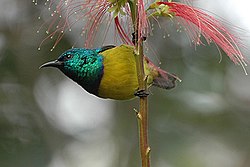| Hedydipna | |
|---|---|
 | |
| Collared sunbird, Hedydipna collaris | |
| Scientific classification | |
| Domain: | Eukaryota |
| Kingdom: | Animalia |
| Phylum: | Chordata |
| Class: | Aves |
| Order: | Passeriformes |
| Family: | Nectariniidae |
| Genus: | Hedydipna Cabanis, 1851 |
| Type species | |
| Cinnyris platurus [1] Vieillot, 1819 | |
| Species | |
H. collaris | |
| Synonyms | |
Anthodiaeta | |
Hedydipna is a genus of sunbirds. It contains the following species, [2] which are sometimes included in genus Anthreptes .
| Image | Scientific name | Common name | Distribution |
|---|---|---|---|
 | Hedydipna collaris | Collared sunbird | sub-Saharan Africa |
 | Hedydipna platura | Pygmy sunbird | Benin, Burkina Faso, Cameroon, Central African Republic, Chad, Democratic Republic of the Congo, Ivory Coast, Ethiopia, Gambia, Ghana, Guinea, Guinea-Bissau, Kenya, Mali, Mauritania, Niger, Nigeria, Senegal, Sierra Leone, Sudan, Togo, and Uganda. |
 | Hedydipna metallica | Nile Valley sunbird | Djibouti, Egypt, Eritrea, Ethiopia, Oman, Saudi Arabia, Somalia, Sudan, Libya, and Yemen |
| Hedydipna pallidigaster | Amani sunbird | Kenya and Tanzania | |
The name Hedydipna comes from the Greek hēdudeipnos, meaning "dainty-supping" or "sweet-eating" — a reference to the nectar sipping habits of these species. [3] These sunbirds are largely restricted to Africa and western islands in the Indian Ocean, though the Nile Valley sunbird is found as far east as Yemen. [4]